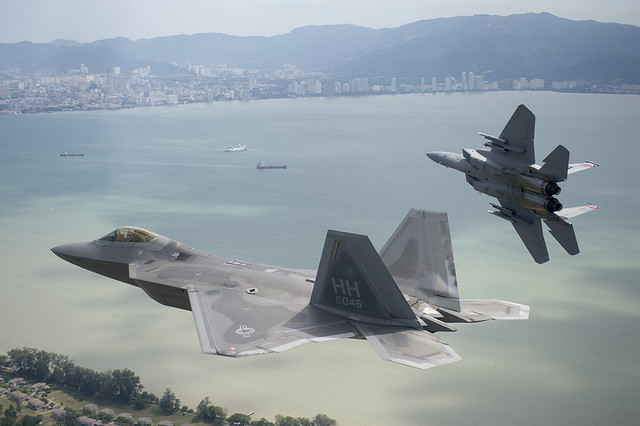Or . . . stealthy and expensive mega-guns?
I’ve been trying to think of something intelligent to contribute to the ongoing debate over future production of the F-22 Raptor. President Obama and Secretary of Defense Robert Gates want to cap production at 187 aircraft, the number currently funded. Congressmen and senators from F-22 producing districts and states want to fund an additional 7 aircraft, at least in part to keep F-22 production facilities (and jobs) going. I think that’s a fair summary of the current situation. You can find additional information and details here.
It is, frankly, difficult to find compelling arguments for a larger F-22 fleet. There is no enemy with an equivalent air superiority threat, nor is there likely to be one during the projected lifetime of the F-22. Our existing fleet of F-15, F-16, and F/A-18 aircraft are quite capable and will remain so for the near term. Farther out, the F-35 joint strike fighter will offer excellent air-to-air and air-to-ground capabilities at lower per-unit costs than the F-22. Secretary Gates has said, in so many words, that he’d rather have 187 F-22s and 2,000 F-35s than 200 F-22s and a much smaller number of F-35s. Logic and budgetary realities suggest that Gates has it right.
Yeah, but . . . I was around for the fighter mix fights of the 1970s, where the movers and shakers of the defense community split into two camps: those who wanted to fund and build the F-15 and F-16, and those who wanted to cancel both programs and build instead thousands and thousands of lesser-capable — but dirt cheap — F-5s.
The F-15 and F-16 were extremely expensive aircraft by 1970s standards, and many defense strategists thought we didn’t need the capability. As the USAF began to field the F-15 in the mid-1970s, the aircraft was beset with problems . . . it was expensive to operate, many of its vaunted new systems didn’t work well, there was a shortage of engines, and the weapons the jet was designed for didn’t yet exist . . . much as it is with the F-22 today. And it was the same a few years later, as the USAF began to field the F-16.
But over time the problems went away. F-15s became more reliable, per-hour flying costs went down, avionics and other systems caught up, the new weapons were developed . . . and we wound up with an air-to-air superiority fighter you could deploy anywhere in the world on short notice, a fighter that has to date racked up a perfect combat kill to loss ratio: 104 to zero.
I am biased, of course . . . I was a USAF F-15 pilot from 1978 to 1997 and I swear by that airplane. I watched it grow. It’s an outstanding fighter, and until the advent of the F-22, the best fighter in the world. I directly benefitted when the pro-modernization forces won the fighter mix battle of the 1970s, and I do not think we would have dominated the skies, ended the Cold War, pre-emptively and immediately gained air superiority over Iraq and Bosnia during the 1990s, or maintained a decade-long, around-the-clock no-fly zone over Iraq, with a fleet of peashooter F-5s.
Still, though, the military-industrial complex Eisenhower warned us about in 1961 seems to have a death grip on our representatives and senators, and if not a death grip at least a pretty damn firm grip on defense policy and budgeting. I’m happy we have 187 F-22s (and I wish I were young enough to fly one). I know from experience that the F-22 fleet will outgrow its current problems. I think, just as with the F-15 and F-16, we will find ourselves in need of the F-22’s capablities at some point . . . but we have enough of them to accomplish any for-now conceivable air superiority mission, and shouldn’t build more.
Update (7/22/09): Click here to read an outstanding article on the F-15 and F-22.
Update (1/10/17): It’s good to go back and review older posts, and this one in particular, since with the election of a Republican president and the continued GOP majority in both houses of congress, I anticipate renewed calls for reopening the F-22 production line. So what do I think now that a few years have passed?
The F-15s currently remaining in service (more than 200 F-15 C & D models) have been upgraded and share many capabilities with the F-22. What’s missing is stealth, and as I remarked in a more recent post, no air force I know wants to go up against a wall of Eagles armed with the same missiles the Raptors carry, stealth or no stealth. It is also true that the two-seat Strike Eagle is still being manufactured, although for foreign customers and not the USAF. Still, we could buy some, right off an existing production line. And new Strike Eagles retain all the air-to-air capability of the old single-seat Eagle.
So yeah, I’m still okay with capping the F-22 at 187 aircraft. But we do need to get on with the F-35, upon which this whole deal depends.

Paul,
My gut feeling is that the projected 187 seems about right, especially with the F-35 in the wings. Unfortunately, we haven’t seen the threat assessments (and won’t) that go along with the Quadrennial Defense Review. What does have me worried is the deterioration of the tanker fleet and the inability of the Department of Defense to contract for a replacement. We can have the world’s most awesome fighter fleet in capability and numbers, but if we can’t deploy it, we got zilch.
No glamor, no money . . . if you think about it, it’s damn near a miracle the USAF has spent the little money it has on tankers.